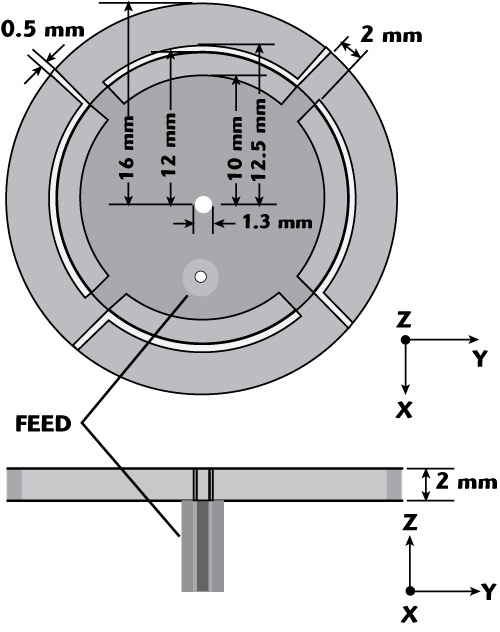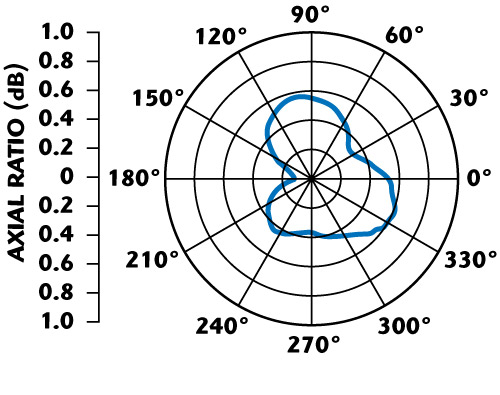As a result of further research, antennas using metamaterials have been published. Planar leaky-wave antennas using transmission-line metamaterials have been reported with continuous beam scanning.1-3 Feeding networks of microstrip patch arrays using transmission-line metamaterials have been designed,4 which removes the inherent pattern squint resulting from the traditional series feeding network. Iizuka and Hall have shown how left-handed transmission lines can be incorporated into dipole antennas and found that the antenna shows a reduced wavelength with decreasing frequency.5 Microstrip patch antennas, loaded with a miniaturized multilayered left-handed (LH) transmission line that increases the effective wavelength of the antenna and thus lowers the resonant frequency of the radiating mode, have been realized.6 As a new type of antenna, zero-order resonator antennas have been explored.7-10 These antennas radiate electromagnetic waves like monopole antennas and simultaneously maintain the inherent advantage of a low profile microstrip patch. However, these antennas are all linearly polarized and, to the authors’ knowledge, omni-directional circularly polarized structures using ZORs have not been reported so far.
In this article, the design, fabrication and measurement of a novel type of an omni-directional, circularly-polarized microstrip antenna are described. The proposed antenna uses a zero order resonance loaded with four identical arc-shaped stubs, which maintains the advantage of a low profile microstrip patch antenna and possess a monopole-like radiation pattern.
Theory

Figure 1 Equivalent circuit of a unit Z0R (a) and its dispersion diagram (b).
Antennas using a ZOR based on a periodic design approach have been studied in detail.9,10 In the circuit model of these antennas, the series capacitance between unit ZORs is needed to represent the electromagnetic coupling, and provides the capacitance realizing the left-handed part of the composite right-/left-handed transmission line. A mushroom ZOR, which consists of a square metallic patch connected to the ground plane by a shorting post, has been considered.9,10 This structure, employing unit ZORs, realizes an omni-directional linear polarization operation. The equivalent circuit model of a ZOR is shown in Figure 1. LR’, CL’, LL’ and CR’ are series inductance and capacitance per unit length and parallel inductance and capacitance per unit length, when the periodic ZORs can be seen as homogeneous media.
By applying the periodic boundary related to the Bloch-Floquet theorem, the unit ZOR dispersion is determined to be:

where the series impedance and shunt admittance are


The series resonance angular frequency and the shunt resonance angular frequency of the unit ZOR are defined as follows:


In general, the series and shunt resonance angular frequencies are not equal. The balance condition is not satisfied and a bandgap exits between the left-handed low pass band and the right-handed high pass band. The bandgap can be described by two cut-off frequencies following:

The dispersion diagram is also shown in the figure. The unit ZOR supports a fundamental left-handed wave (phase advance) at lower frequencies and a right-handed wave (phase delay) at higher frequencies. By periodically cascading unit ZORs of length p, N times, the final structure can still be considered a resonator under the resonance condition

where n is the resonance mode number, which can be zero, or a positive or negative integer.11 In the case of open boundary conditions, the zero-order resonance angular frequency is determined by the shunt resonance angular frequency ωsh.10 When the ZOR operates in the zero order mode, the ZOR antenna radiates the electromagnetic wave omni-directionally, like a monopole antenna with finite ground plane.

Figure 2 Equivalent circuit of the proposed antenna.
In this article, a circular mushroom ZOR is considered. By loading the patch with four identical arc-shaped stubs along the patch perimeter, a circumfluent current can be obtained and thus omni-directional, circularly polarized radiation can also be realized. Figure 2 shows the equivalent circuit model of the proposed structure. The loaded arc-shaped stubs extend the current path of the patch of the ZOR and act as an increase in the area of the patch, which can be further considered as increasing the shunt capacitance and series inductance. The series capacitance between unit ZORs is not included in the circuit model of the proposed antenna, since only one unit ZOR is used. The resonant frequency of the proposed ZOR antenna is determined by the shunt resonance as follows:

Design of the Omni-directional, Circularly Polarized Antenna

Figure 3 Layout of the proposed antenna.
The layout of the proposed ZOR antenna is shown in Figure 3. The feed point is located at (6 mm, 0 mm, 0 mm). The four stubs extend the current on the patch, increasing the patch area that is the shunt capacitance. Based on Equation 9, the resonant frequency will be lower than that of the ZOR antenna without the four loaded stubs.
Input Impedance and Matching

Figure 4 Input impedance of the proposed antenna without ring slot.

Figure 5 Input impedance of the proposed antenna with ring slot.
The input impedance of the ZOR antenna without any matching is shown in Figure 4. It can be seen that the real part of the input impedance is very large at the resonance frequency and the ZOR antenna is badly mismatched to the 50 Ω feed line. Appropriate matching means must be added to match to the 50 Ω feed line. Here, a ring slot is adopted to improve the matching of the ZOR antenna, whose dimensions are optimized by using HFSS. A ring slot with an outer radius of 2.1 mm and an inner radius of 1.7 mm is used. Figure 5 shows the input impedance of the ZOR antenna with the matching ring slot. It can be seen that the matching of the ZOR antenna is greatly improved after adopting the ring slot.
Effect of Dimensions of the Loaded Stubs on the Axial Ratio

Figure 6 Current distribution.
The current distribution in the patch of the ZOR antenna is plotted in Figure 6. The in-phase current distribution on the patch and loaded stubs can be observed. The radiation of the radial current simulates the function of the electric monopole antenna and the radiation of the circumfluent current simulates the function of the magnetic monopole antenna. The electric and magnetic monopole antenna have the same phase center, that is the geometrical center of the ZOR antenna, but they have not the same original phase. If the electric and magnetic monopole antenna are equal in terms of magnitude and orthogonal in terms of phase, the circularly polarized operation can be realized. The magnitude of circumfluent current has relevant relations with the dimensions of the loaded stubs. The difference of the original phase of the radial and circumfluent current is determined by the distance between the stubs and the patch sides. The axial ratio changes with the dimensions of the loaded stubs and the distance between the stubs and the patch sides. The proposed antenna realizes left hand circular polarization. If the stubs are loaded inversely along the patch perimeter, right hand circular polarization can be realized.
Antenna Realization

Figure 7 Prototype of the proposed antenna.
In order to obtain good circular polarized performance, the relevant parameters of loaded stubs are optimized by using HFSS and are shown in the layout figure. Figure 7 shows the prototype of the proposed antenna. It uses a Teflon substrate with a dielectric constant of 2.65 and a height of 2 mm.
Simulation and Measurement Results

Figure 8 Simulated and measured return loss.

Figure 9 Simulated and measured radiation patterns in the x-y plane: (a) horizontal component and (b) vertical components.

Figure 10 Simulated axial ratio of the proposed antenna in the x-y plane.
The simulated and measured return losses are displayed in Figure 8. The operational frequency of the proposed antenna is 1.9 GHz. The difference between the two curves may be due to the fact that the top patch is loaded with stubs and the current path is extended. However, the ground plane is not large enough and the current on it may flow on the outer surface and even on the outer surface of the coaxial line. This acts as an effective impedance matching. The proposed antenna provides a 10 dB input return loss and bandwidth of 11.8 percent. Figure 9 shows the simulated and measured radiation patterns of the vertical and horizontal polarization components in the x-y plane. It can be seen that omni-directional radiation is obtained for the proposed antenna. The radiation non-circularity of the proposed antenna may be attributed to fabrication errors and measurement environment. Figure 10 plots the simulated axial ratio of the proposed antenna in the x-y plane. It can be observed that the proposed antenna has a good omni-directional axial ratio performance. By using the gain comparison method, the measured gain of the proposed antenna is 0.2 dB.
Conclusion
A new type of low profile omni-directional, circularly polarized antenna is designed, fabricated and measured. The proposed antenna has a good performance in size, a radiation pattern similar to a monopole antenna and can provide a large service area. The proposed antenna can find wide applications in the mobile and wireless local area network (WLAN) systems due to its good performance in axial ratio, size and service area.
Acknowledgment
This work was supported by the National High Technology Research and Development Program of China (2007AA701412).
References
1. A.K. Iyer and G.V. Eleftheriades, “Leaky-wave Radiation from Planar Negative-refractive-index Transmission-line Metamaterials,” 2004 IEEE Antennas and Propagation Society Symposium Digest, Vol. 2.
2. C.A. Allen, K.M.K.H. Leong and T. Itoh, “Design of a Balanced 2D Composite Right-/Left-handed Transmission Line Type Continuous Scanning Leaky-wave Antenna,” IET Microwave Antennas and Propagation, Vol. 1, No. 3, June 2007, pp. 746-750.
3. S.J. Lim, C. Caloz and T. Itoh, “Metamaterial-based Electronically Controlled Transmission-line Structure as a Novel Leaky-wave Antenna with Tunable Radiation Angle and Beamwidth,” IEEE Transactions on Microwave Theory and Techniques, Vol. 53, No. 1, January 2005, pp. 161-173.
4. Z.X. Zhang and S.J. Xu, “A Novel Parallel-series Feeding Network of Microstrip Patch Arrays with Composite Right-/Left-handed Transmission Line for Millimeter-wave Applications,” International Journal of Infrared and Millimeter Waves, Vol. 26, No. 9, September 2005, pp. 1329-1341.
5. H. Iizuka and P.S. Hall, “Left-handed Dipole Antennas and Their Implementations,” IEEE Transactions on Antennas and Propagation, Vol. 55, No. 5, May 2007, pp. 1246-1253.
6. K.Z. Rajab, R. Mittra and M.T. Lanagan, “Size Reduction of Microstrip Patch Antennas with Left-handed Transmission Line Loading,” IET Microwave Antennas and Propagation, Vol. 1, No. 1, February 2007, pp. 39-44.
7. G.V. Eleftheriades and R. Islam, “Enabling RF/Microwave Devices and Antennas Using Negative-refractive-index Transmission-line (NRI-TL) Metamaterials,” 2007 IEEE Loughborough Antennas and Propagation Conference Digest, pp. 13-18.
8. F. Qureshi, M.A. Antoniades and G.V. Eleftheriades, “A Compact and Low-profile Metamaterial Ring Antenna with Vertical Polarization,” IEEE Antennas and Wireless Propagation Letters, Vol. 4, 2005, pp. 333-336.
9. J.G. Lee and J.H. Lee, “Zeroth Order Resonance Loop Antenna,” IEEE Transactions on Antennas and Propagation, Vol. 55, No. 3, March 2007, pp. 994-997.
10. A. Lai, K.M.K.H. Leong and T. Itoh, “Infinite Wavelength Resonant Antennas with Monopolar Radiation Pattern Based on Periodic Structures,” IEEE Transactions on Antennas and Propagation, Vol. 55, No. 3, March 2007, pp. 868-876.
11. A. Sanada, C. Caloz and T. Itoh, “Zeroth Order Resonance in Composite Right-/Left-handed Transmission-line Resonators,” 2003 Asia-Pacific Microwave Conference Proceedings, Vol. 3, pp. 1588-1592.
